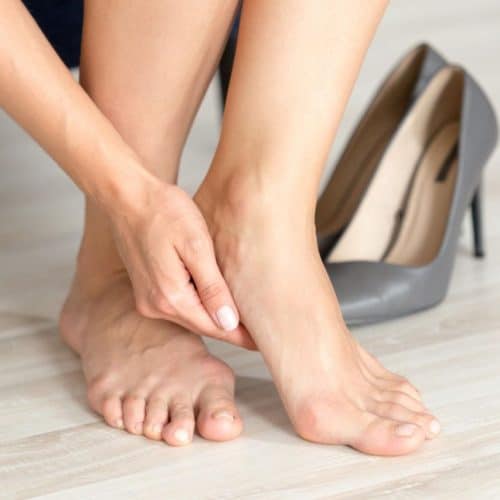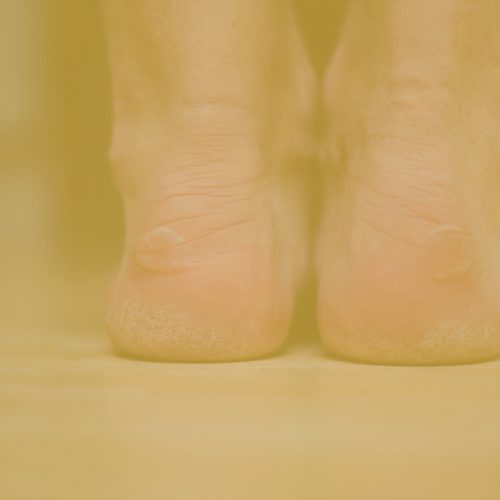Common foot ailment Morton’s neuroma affects many individuals globally. Tissue thickening around a toe nerve causes it to hurt. This might create a strong, searing pain in the ball of the foot that can spread to the toes. Standing on a stone in your shoe or a wrinkle in your sock might feel uncomfortable. Fortunately, there are numerous therapies for this problem.
Rest and Ice
Resting the foot is one of Morton’s neuroma’s most common treatments. Breaking from foot-stressing activities, especially those that entail weight on the ball of the foot, can help relieve discomfort and avoid future aggravation. Rest and ice might help the afflicted region.
Ice reduces inflammation and numbs Morton’s neuroma’s intense, searing pain, bringing instant relief. To avoid frostbite, use ice at intervals without touching the skin. Using an ice pack or towel can help. Rest and ice can help Morton’s neuroma patients heal.
Orthotic Therapy
Orthotic therapy is crucial to Morton’s neuroma treatment. Orthotic shoe inserts relieve pressure, support the arch, and cushion sensitive regions. Orthotic treatment for Morton’s neuroma reduces nerve pressure and pain.
Custom orthotics designed for a person’s foot form and needs are beneficial. These are made by examining the foot’s structure, gait, and pressure spots. For Morton’s neuroma patients, bespoke orthotics can relieve nerve compression by straightening the foot and distributing weight evenly.
Orthotic devices can help alleviate foot abnormalities or biomechanical difficulties that may be causing or worsening the neuroma. People with flat feet or excessive pronation may be more prone to Morton’s neuroma. Orthotics can support the arch, improving foot function.
Custom orthotics are beneficial, although over-the-counter orthotic insoles can help some people. These are cheaper and excellent for minor symptoms. A podiatrist or orthopaedic expert can provide tailored remedies for more severe situations or continuous discomfort.
Offloading with Metatarsal Domes
Metatarsal dome offloading is a specific Morton’s neuroma pain treatment. This method redistributes foot pressure, especially in the metatarsal area most impacted by this ailment.
Differently shaped metatarsal domes are strategically put within shoes beneath the ball of the foot. Their dome-shaped construction elevates and supports metatarsal bones to prevent compression. These domes relieve pressure on the neuroma, cushioning the nerve.
Metatarsal domes’ simplicity and efficacy make them beautiful. They gently modify the foot’s mechanics to disperse weight and force when walking or running. This prevents the nerve from being pinched or inflamed, relieving Morton’s neuroma’s acute, burning symptoms.
These domes can change things for continually on-foot or high-impact athletes. They relieve pain immediately and avoid nerve compression by maintaining the foot’s structure.
Metatarsal domes are available in various sizes and materials over the counter, but certain people may benefit from a tailored solution. A podiatrist or foot specialist may evaluate a foot’s anatomy and needs to propose shoes that fit and relieve.
Offloading using metatarsal domes is a non-invasive, cost-effective, and efficient technique to manage Morton’s neuroma, allowing people to resume their regular routines without foot pain.
Shockwave Therapy
Shockwave therapy, or extracorporeal shock wave therapy (ESWT), is a non-invasive, novel treatment for musculoskeletal diseases, including Morton’s neuroma. Healing and pain alleviation are achieved by targeting and stimulating the damaged region with high-energy acoustic waves.
Interesting process underlying shockwave treatment. The afflicted area experiences controlled microtrauma from shockwaves. Microtrauma boosts blood circulation, speeds cellular repair, and reduces muscular tension. Morton’s neuroma patients have less inflammation, discomfort and faster nerve tissue recovery.
Shockwave treatment may penetrate deep tissues without surgery or intrusive procedures, making it unique. Five to twenty-minute therapy sessions are typical. A gel is placed on the foot to help transmit shockwaves, and a portable device delivers them to the targeted location. Patients may feel tapping, but the process is usually painless and needs no anaesthesia.
Shockwave treatment has several benefits for Morton’s neuroma sufferers. Besides relieving pain, the therapy can reduce scar tissue, restore mobility, and enhance foot function. Non-surgical treatments provide little downtime so patients can quickly return to normal activities.
Many patients recover after a few sessions; however, the number of treatments depends on severity and reaction. ESWT specialists must be consulted to select the optimal treatment regimen.
Footwear Modifications
Morton’s neuroma therapy relies on footwear changes. In situations like Morton’s neuroma, the appropriate shoes may make all the difference between comfort and chronic discomfort.
Morton’s neuroma footwear changes aim to relieve nerve strain, allow for toes, and distribute weight evenly. Footwear alterations are examined in detail:
- Wider Toe Box: Shoes with tiny toe boxes might pinch the toes, compressing the neuroma. Wearing shoes with a bigger toe box lets your toes extend, relieving nerve strain. A simple switch can relieve the problem immediately and avoid further deterioration.
- Avoiding High Heels: High-heeled shoes, especially those above two inches, put too much pressure on the ball of the foot. This can exacerbate neuroma compression and discomfort. Morton’s neuroma patients should avoid high heels or adopt lower, more sturdy ones.
- Rocker Soles: The soles of rocker sole shoes are thick and rounded. This innovative shape encourages natural foot rolling when walking, decreasing ball-of-foot strain. Rocker soles relieve direct pressure on Morton’s neuroma, making extended standing or walking more comfortable.
- Cushioned Insoles: Adding cushioned insoles or padding to shoes can provide an extra layer of protection and comfort. These insoles can absorb shock, reduce pressure on the neuroma, and offer a more supportive base for the foot.
- Material Considerations: Shoe material also crucial. Airy fabrics like leather or canvas decrease perspiration and fungal infections. Flexible fabrics also conform to the foot for a comfortable fit without tightness.
- Arch Support: Proper arch support is crucial, especially for those with flat feet or high arches. Shoes with good arch support can distribute weight evenly across the foot, preventing excessive pressure on the neuroma.
Incorporating these footwear modifications not only aids in managing the symptoms of Morton’s neuroma but also promotes overall foot health.
Foot Mobilisation and Manipulation Techniques
Therapeutic movement and manipulation enhance foot anatomy, function, alignment, and mobility. These procedures are helpful for Morton’s neuroma, where nerve compression causes discomfort and reduced movement.
Foot mobilisation softly moves and stretches joints and soft tissues to restore natural mobility. Our feet might acquire misalignments or mobility limits from inappropriate footwear, accidents, or ageing. These misalignments might impinge on the nerve, worsening Morton’s neuroma.
Here’s a deeper exploration of foot mobilisation and manipulation techniques:
- Joint Mobilisation: The therapist gently massages the patient’s foot joints to enhance range of motion and rectify misalignments. Ensure each joint moves properly to avoid neuroma pressure.
- Soft Tissue Manipulation: Beyond the joints, the foot has a complex network of muscles, tendons, and ligaments. Techniques like massage or myofascial release can relax tight muscles, improve blood flow, and reduce adhesions or scar tissue contributing to nerve compression.
- Stretching Exercises: Patients are often taught specific stretches to maintain the flexibility and strength of the foot. Regular stretching can prevent the recurrence of tightness and ensure that the foot’s structures remain balanced and functional.
- Strengthening Techniques: A strong foot can better support and protect its structures, including the nerves. Therapists might introduce exercises that target the foot’s intrinsic muscles, ensuring that they can adequately support the arch and distribute pressure evenly across the foot.
- Gait Analysis and Retraining: Our gait affects foot pressure distribution. A therapist may examine a patient’s stride and adjust or retrain it to reduce neuroma pressure.
- Functional Integration: This involves ensuring that the foot functions optimally as part of the lower limb. Sometimes, issues in the knee or hip can influence foot function. Therapists look at the foot holistically, ensuring it works harmoniously with the rest of the body.
The beauty of foot mobilisation and manipulation techniques is that they are non-invasive and can often provide immediate relief. Moreover, they empower patients by giving them the tools and knowledge to manage their condition proactively.
Tool-Assisted Massage
The therapeutic approach of instrument-assisted soft tissue mobilisation (IASTM) uses specifically developed instruments to improve massage efficacy and precision. Since it treats soft tissue dysfunctions, this method has become popular for Morton’s neuroma.
Tool-assisted massage breaks down soft tissue scar tissue, adhesions, and fascial limitations. Due to accidents, inflammation, or repetitive strain, foot soft tissues might develop these troublesome regions, causing discomfort, movement difficulties, and other dysfunctions.
Here’s a deeper exploration of tool-assisted massage:
- Enhanced Precision: This method uses various forms and sizes of stainless steel or other stiff implements. Their design lets therapists hit certain locations better than with their hands. This helps with tiny, localised conditions like Morton’s neuroma nerve compression.
- Increased Depth and Pressure: The rigidity of the tools allows deeper penetration into the tissues. This means that deeper layers of fascia, muscles, and tendons can be effectively targeted, ensuring a comprehensive treatment.
- Stimulation of Blood Flow: The massage’s friction and the tools’ pressure promote increased blood circulation to the treated area. Enhanced blood flow brings oxygen and essential nutrients, promoting healing and reducing inflammation.
- Reduction of Scar Tissue: Scar tissue can be less elastic than healthy tissue, leading to restrictions in movement and potential pain. The tools can effectively break down these scar tissues, restoring flexibility and function to the foot.
- Feedback Mechanism: The tools provide a unique feedback mechanism for therapists. As they glide the instruments over the skin, tissue density, texture, and temperature variations can be easily felt, allowing therapists to identify and address problematic areas more effectively.
- Patient Comfort: While the technique might sound intense, it’s often well-tolerated by patients. The tools can cover a larger surface area, distributing pressure more evenly and reducing the discomfort often associated with deep tissue massage.
- Post-Treatment Effects: Patients may experience redness or bruising after a tool-assisted massage. It signifies increased blood flow and is normal. Post-treatment care should include ice or mild stretching to increase benefits and limit pain.
Medications
Drugs relieve symptoms and reduce inflammation, which is essential for Morton’s neuroma treatment. Anti-inflammatory medicines like ibuprofen are often used to relieve pain and swelling. These drugs target the body’s inflammatory response to prevent thicker nerve tissue from inflaming, which can worsen pain.
Corticosteroid injections may help with severe or chronic symptoms. A strong anti-inflammatory medication is injected directly into the neuroma, delivering immediate and often long-lasting relief. One benefit of corticosteroid injections is that they target inflammation without damaging the rest of the body. Repetitive injections might have negative effects, including tissue weakening, so exercise caution.
For any medical intervention, visit a healthcare practitioner to identify the best pharmaceutical regimen. This maximises drug advantages while minimising dangers and negative effects.
Conclusion
In conclusion, Morton’s neuroma, while painful, is treatable. If you suspect you have this condition, it’s essential to consult with a podiatrist or orthopaedic specialist to get a proper diagnosis and begin the most suitable treatment for your situation.









